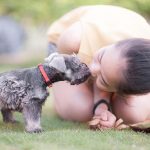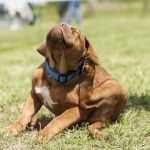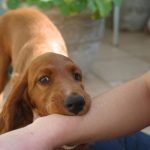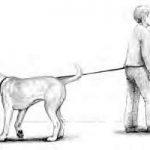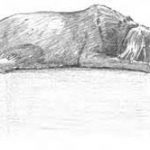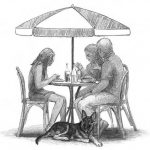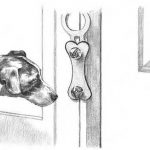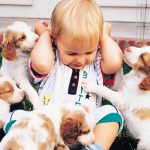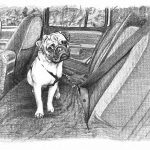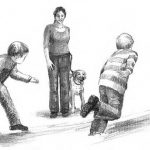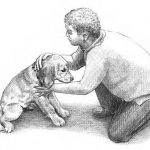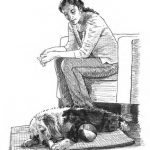Profiling the Working Group


In This Chapter
- Defining the Working category
- Getting to know the workers
- Understanding the needs of sled dogs
- Socializing a protective breed
The Working Group is a formidable assemblage, made up of dogs of great strength, courage, and devotion. The AKC category of Working Dog describes breeds that were originally bred for jobs other than herding or hunting: carting, sledding, guarding, and rescuing. Though many machines now do these jobs (snowmobiles rather than sledding dogs, for example), plenty of Working breeds are still doing their jobs throughout much of the world.
The breeds in the Working Group are built to perform tough tasks. They are sturdy and strong and capable of carrying heavy loads. They are brave enough to guard against predators and intruders, as well as accompany soldiers into war. They have specialized skills that allow them to dive underwater, perform rescues, and detect drugs and explosives. These breeds are intelligent and able to think for themselves, a true asset when a dog must act alone to get a job done.
Though they excel at these tasks, the Working breeds are typically large to giant — Great Dane, Akita, Mastiff, and Doberman Pinscher, to name a few — which may make them a challenge for the average person interested in a pet. Fortunately, they are also quick to learn, and early and proper training can help a dog stay on track as a home companion. Without training, however, the typical owner will be challenged to control such large and powerful dogs. Socialization should be done early and throughout a dog’s life, to prevent the dog from becoming overprotective, especially if you ever plan to bring new people into your life.
Working dogs may be similar in size, but they vary greatly in other aspects of appearance. From the corded white coat of the Komondor to the baggy, smooth coat of the Neapolitan Mastiff, the dogs of the Working Group have quite a range of hair types. Being workers, of course, coat type has everything to do with job performance: The Komondor’s cords protect it from the elements and allow it to blend in with its flock; the Neapolitan Mastiff’s unusual appearance is enough to stop any intruder in his tracks.
In general, Working dogs are territorial and make excellent guard dogs because of their physical size and the volume of their bark. What burglar would hear the booming alarm bark of a Rottweiler and decide to come on in?
Despite their size, some of the Working breeds are perfectly content with a minimal amount of exercise and can even live happily in a small home or apartment. The Mastiff types, for example, don’t require strenuous exercise and can do well with a daily leisurely stroll. The sled dogs are a different story, however, and are quite active. Be prepared for more exercise and play if you have an Alaskan Malamute, Samoyed, or Siberian Husky. Dogs like the Portuguese Water Dog, the Boxer, and the Standard Schnauzer also benefit from more activity than others in the Working Group.
Whether guardian or powerhouse, Working dogs love nothing better than having a job to do. For some that means being a drug-sniffing police dog, a therapy dog at a nursing home, or a sled dog in the Iditarod. For others, it means keeping a careful eye on a backyard full of children. And nothing is better than celebrating a job well done with a well-deserved snooze at your master’s feet.
Akita
History/Evolution: The largest of Japan’s seven native breeds, the Akita specialized in hunting and guarding. Beloved in Japan as loyal pets and companions, the breed was named one of the country’s national monuments in 1931. Helen Keller brought the first Akita to the U.S. when she returned from a trip to Japan; American servicemen also brought back the dogs from World War II. Recognized by the AKC in 1972, the Akita continues to gain admirers.
Size: Large; females 24 to 26 inches, 75 to 95 pounds; males 26 to 28 inches, 85 to 115 pounds.
Color: Any color, including white, brindle, or pinto.
Temperament: Bold, alert, dignified, and courageous; devoted and protective of family members; can be aggressive toward other dogs.
Energy level: Medium.
Best owner: Experienced in obedience training and time for daily physical exercise.
Needs: Daily outdoor runs (leashed or in a yard with a 6-foot fence), weekly brushing (more often during seasonal shedding) and cool climate.
Life expectancy: 10 to 12 years.
Photograph © Isabelle Francaise
Alaskan Malamute
History/Evolution: One of the oldest sled dogs, the Alaskan Malamute evolved in Alaska. There they hunted with native peoples for seals and polar bears, and then hauled the catch back to the village. The arrival of white settlers brought mixed breeding until the 1920s, when people interested in sled dog racing began to breed the traditional malamutes. A noted contributor to Admiral Byrd’s trek to the South Pole in 1933, the AKC recognized the breed in 1935.
Size: Large; females 23 inches, 75 pounds; males 25 inches, 85 pounds.
Color: Light gray to black, red, or sable with white markings, also all white; brown eyes (unlike the blue eyes of its Siberian cousin).
Temperament: Affectionate, friendly, playful, and loyal. Behaves well if given enough exercise; can be territorial with other pets.
Energy level: Low to medium.
Best owner: Active owner with time for adequate exercise (long walks, runs) maintaining firm, consistent methods of training.
Needs: Daily doses of vigorous exercise, daily brushing, cool climate.
Life expectancy: 10 to 12 years.
Photograph © Jean Fogle
Anatolian Shepherd Dog
History/Evolution: More guard dog than herder, the Anatolian Shepherd Dog has origins in ancient Turkey, with probable ties to the Tibetan Mastiff and Roman Mallosian war dogs. The dogs served as staunch defenders of livestock and are still valued for their hardiness, loyalty, and independence. The breed became more widely known and appreciated by the 1980s; the AKC accepted it in 1996.
Size: Giant; females from 27 inches, 80 to 120 pounds; males from 29 inches, 110 to 150 pounds.
Color: Fawn, brindle, tricolor, white, black mask.
Temperament: Serious about its job as protector, yet calm and easygoing. Intelligent, adaptable, and territorial; may perceive children as part of flock to be guarded.
Energy level: Low (except when a threat is perceived).
Best owner: Strong owner in a rural or suburban home.
Needs: A job (guard, patrol, slipper fetcher) and socialization from an early age; daily exercise and securely fenced yard.
Life expectancy: 10 to 13 years.
Photograph © Isabelle Francaise
Bernese Mountain Dog
History/Evolution: The Bernese Mountain Dog is perhaps the most well known of the four varieties of Swiss Mountain Dogs, distinct from the other three by its long, silky coat. A hardy dog who can thrive in cold weather, the Bernese Mountain Dog retains its original skills as a draft dog, herder, and watchdog. Prized in Switzerland for centuries, the breed is now popular throughout Europe and the United States, and acquired AKC recognition in 1937.
Size: Large; females 23 to 26 inches, 70 to 100 pounds; males 25 to 271⁄2 inches, 70 to 120 pounds.
Color: Tricolor (black with white and rust markings).
Temperament: Alert, good natured, and calm. Extremely devoted, does well with children; gets along with other pets but is aloof with strangers.
Energy level: Low to medium.
Best owner: Families who include a dog in the family’s schedule and activities.
Needs: Daily moderate exercise and twice-weekly coat brushing; quality time with human family (isolation leads to bad habits and unhappiness).
Life expectancy: 8 to 10 years.
Photograph © Jean Fogle
Black Russian Terrier
History/Evolution: Developed in the mid-1900s in the Soviet Union, Black Russian Terriers were bred to be large, highly trainable dogs who could work with security forces as guard dogs. The breed is the result of crossings with many breeds, primarily Airedale Terrier, Giant Schnauzer, and Rottweiler. Spreading through Europe and then to the U.S., the Black Russian Terrier was accepted into the AKC’s Miscellaneous Class in 2001 and the Working Group in 2004.
Size: Large, 80 to 145 pounds; female 26 to 29 inches; male 27 to 30 inches.
Color: Black (sometimes with a few gray hairs).
Temperament: Calm, confident, and courageous; protective and attached to their family. Bred to guard; reserved toward strangers.
Energy level: Low.
Best owner: An active owner who has the time and energy for obedience training and daily exercise.
Needs: Job or activity such as obedience or agility training; exercise, socialization, and human contact.
Life expectancy: 10 to 11 years.
Photograph © Isabelle Francaise
Boxer
History/Evolution: Boxer origins trace back to the 16th century, with ancestors that include Tibetan fighting dogs, central European hunting dogs, and bulldogs. Today’s Boxer owes much of its development to German breeders in the 1800s. One of the first breeds to serve as police and military dogs in Germany, by 1900 the Boxer had become a beloved pet. Recognized by the AKC in 1904, the Boxer soared in popularity in the 1940s to its current high ranking.
Size: Medium to large; female 21 to 231⁄2 inches, 50 to 65 pounds; male 221⁄2 to 25 inches, 65 to 80 pounds.
Color: Fawn or brindle, usually with white markings.
Temperament: Intelligent, alert, courageous, and self-assured. Playful and exuberant, but patient with children.
Energy level: High (not hyperactive), mellows with age.
Best owner: Active family with a fenced yard.
Needs: Human contact (obedience, therapy, and companionship) and exercise (agility, play, leashed walks).
Life expectancy: 8 to 12 years.
Photograph © Jean Fogle
Bullmastiff
History/Evolution: The Bullmastiff was developed in England in the 1800s to help gamekeepers keep poachers out of estates and game preserves. The dog needed to track quietly and pin and hold poachers without mauling them. The winning combination of size, speed, and ferociousness turned out to be 60 percent Mastiff and 40 percent Bulldog. Today, as a companion, the Bullmastiff still can be counted on for its watchdog abilities. The AKC recognized the breed in 1933.
Size: Large; females 24 to 26 inches, 100 to 120 pounds; males 25 to 27 inches, 110 to 130 pounds.
Color: Red, fawn, and brindle.
Temperament: Gentle, quiet, devoted guardian and companion. Intelligent, stubborn when it comes to obedience training.
Energy level: Low.
Best owner: Firm but loving owner who has time and patience for training.
Needs: Moderate daily exercise (leashed), socialization, roomy indoor accommodations (soft, comfy bed), slobber maintenance.
Life expectancy: 8 to 10 years.
Photograph © Isabelle Francaise
Doberman Pinscher
History/Evolution: The Doberman Pinscher, which originated in Germany around 1900, gets its name from Louis Dobermann, a tax collector who wanted a dog to accompany and protect him as he worked. The German Pinscher, Rottweiler, Black and Tan Terrier, and Weimaraner were probably used to develop the Doberman. Intelligence and ability makes it among the finest police dogs, guard dogs, and war dogs. A noted show dog, the Doberman has also become a beloved and loyal family pet.
Size: Medium to large, 60 to 85 pounds; females 24 to 26 inches; males 26 to 28 inches.
Color: Black, red, blue, or fawn, all with rust markings.
Temperament: Energetic, watchful, and fearless. Loyal and intelligent. Reserved with strangers and may be aggressive with strange dogs.
Energy level: High.
Best owner: Active owner; a firm person who has time and energy for training.
Needs: Daily mental and physical exercise (vigorous runs, long walks, agility), indoor companionship.
Life expectancy: 10 to 12 years.
Photograph © Jean Fogle
Dogue de Bordeaux
History/Evolution: Although the history of the Dogue de Bordeaux is steeped in mystery, it is generally agreed that the ancient breed shares its ancestry with Molossers such as Mastiffs and Bulldogs. The Dogue de Bordeaux was a prized hunter, fighter, and guardian, found in homes of wealthy French. The breed suffered setbacks during the French Revolution and World War II, but rebounded and realized its fame in the U.S. after one of its kind co-starred in the 1989 film Turner and Hooch.
Size: Giant; females 23 to 26 inches, from 99 pounds; males 231⁄2 to 27 inches, from 110 pounds.
Color: Shades of fawn to mahogany.
Temperament: Gifted and courageous guardian, but not aggressive; loyal and affectionate. Can coexist with older children with supervision.
Energy level: Low.
Best owner: Confident, active owner able to handle the breed’s size and strength.
Needs: Extensive socialization, daily exercise, patient and positive obedience training.
Life expectancy: 10 to 12 years.
Photograph © Jean Fogle
German Pinscher
History/Evolution: Although the German Pinscher resembles other Pinschers and the Doberman, it is more closely associated with the Standard Schnauzer. Traced to Germany in the 1600s, the German Pinscher was known as a hard-working ratter around stables. It faced extinction after World War II but was rescued by dedicated breeders. It was accepted into the Working Group of the AKC in 2003. These dogs are loyal, high-energy companions that retain natural hunting abilities and protective instincts.
Size: Medium, 17 to 20 inches, 25 to 35 pounds.
Color: Fawn to red to stag red; black and tan, blue and tan.
Temperament: Alert, vivacious, and courageous; a guard dog with highly developed senses. Intelligent, independent, and playful.
Energy level: High.
Best owner: Active owner able to dole out consistent discipline; families with older children.
Needs: Daily exercise (fenced yard or twicedaily walks), socialization, companionship, and obedience training.
Life expectancy: 12 to 15 years.
Photograph © Isabelle Francaise
Giant Schnauzer
History/Evolution: Developed in Germany, the Giant Schnauzer is joined in the Schnauzer breed by the Miniature and Standard Schnauzers. Through crossings with smooth-coated cattle dogs, sheepdogs, Great Danes, and probably others, the breed developed into a capable cattle and driving dog who could withstand varying weather conditions; butchers and breweries also used them as guard dogs. The intelligent dogs later excelled as trained police dogs during World War I.
Size: Large; females 231⁄2 to 251⁄2 inches, 65 to 80 pounds; males 251⁄2 to 271⁄2 inches, 80 to 95 pounds.
Color: Solid black or pepper and salt.
Temperament: Bold and protective, reserved with strangers; playful and boisterous. Happy when working. May herd children or tend toward overprotective.
Energy level: Medium to high.
Best owner: Confident and firm with time to dedicate to training and companionship.
Needs: Daily exercise and play, obedience training, fenced yard; daily beard cleaning, weekly combing and professional shaping twice a year.
Life expectancy: 10 to 12 years.
Photograph © Jean Fogle
Great Dane
History/Evolution: The distinguished Great Dane’s origins can be traced to ancient crossings that included English Mastiff, Irish Wolfhound, and Greyhound. By the 14thcentury, Great Danes were prized in Germany as swift and powerful wild boar hunters. As time went on, the breed gained in popularity with wealthy landowners because of its imposing and noble appearance. Though their size can be limiting, Great Danes continue to impress show people and pet owners alike.
Size: Giant; females 30 inches or more, 100 to 135 pounds; males 32 inches or more, 145 to 185 pounds.
Color: Brindle, fawn, blue, black, mantle, and harlequin (white with black patches).
Temperament: Spirited, courageous, friendly, and dependable. With proper training and supervision, makes a fine family companion.
Energy level: Medium.
Best owner: Confident owner in a suburban or rural home with time for training and exercise.
Needs: Fenced yard, early socialization, companionship; soft bedding and elevated food bowls (to help prevent bloat).
Life expectancy: 7 to 10 years.
Photograph © Jean Fogle
Great Pyrenees
History/Evolution: The Great Pyrenees gets its name from the European mountain range where it has long guarded flocks of sheep, but its origins can be traced to Asia Minor around 10,000 BC. In medieval France, the imposing white dogs were prized by royalty and nobility. Although the Great Pyrenees has suffered setbacks, conscientious and focused breeding has allowed the breed to continue, achieving moderate popularity in the U.S. The Great Pyrenees achieved AKC recognition in 1933.
Size: Giant; females 25 to 29 inches, 85 pounds; males 27 to 32 inches, 115 pounds.
Color: White or white with markings of gray, badger, reddish brown, or tan, especially on the head.
Temperament: Confident, territorial, and protective; affectionate, loyal, but reserved and serious. May try to dominate and wander off-leash, and tends to bark.
Energy level: Low to medium.
Best owner: Active owner with a large, fenced yard; someone strong enough to manage a giant, strong-minded dog.
Needs: Early training and socialization, kind firmness, daily exercise, leashed outings, weekly brushing (more when shedding).
Life expectancy: 10 to 12 years.
Photograph © Jean Fogle
Greater Swiss Mountain Dog
History/Evolution: The Greater Swiss Mountain Dog is the largest and oldest of the Swiss Mountain Dogs native to Switzerland. With a heritage traced to Mastiff-type dogs that ancient Romans introduced to the area, the breed is a skilled herder, drafter, and guardian of home and livestock. Although machines have taken over many of its duties, the breed has enjoyed a slow but steady growth in interest as companions. In 1995 the breed achieved recognition by the AKC.
Size: Giant; females 231⁄2 to 27 inches, 85 to 90 pounds; males 251⁄2 to 281⁄2 inches; 90 to 130 pounds.
Color: Black and rust and white.
Temperament: Faithful, sensitive, devoted family companion. Calm and easygoing, but territorial, alert, and vigilant.
Energy level: Medium.
Best owner: Family with roomy, fenced yard.
Needs: Moderate exercise, early socialization and training, an owner who is a leader; participant in family goings-on.
Life expectancy: 10 to 12 years.
Photograph © Isabelle Francaise
Komondor
History/Evolution: The Komondor is a breed that has worked for centuries guarding livestock in Hungary. The breed’s unusual coat allows it to blend in with sheep and also serves as armor against the jaws of predators. Although uncommon everywhere but in Hungary, Komondors were brought to the U.S. in 1933 and have been effectively used in the to guard livestock and fend off coyotes and bobcats. As pets, Komondors require extra consideration for their corded coat and independent nature.
Size: Large to giant; females 251⁄2-plus inches, 80-plus pounds; males 271⁄2-plus inches, 100-plus pounds.
Color: White.
Temperament: A natural protector; vigilant, courageous, and faithful. Calm; reserved with strangers, may be overprotective of children.
Energy level: Low to medium.
Best owner: Active owner with time for exercise and consistent training.
Needs: Fenced yard, daily exercise, obedience training, fair but firm handling, socialization. Coat care requires separation of unusual cords and time-consuming bathing.
Life expectancy: 10 to 12 years.
Photograph © Isabelle Francaise
Kuvasz
History/Evolution: An ancient breed, the Kuvasz can trace its origins to Hungary in the Middle Ages and Tibet and Turkey before that; the name probably is derived from the Turkish kawasz, meaning “armed guard of the nobility.” Although the Kuvasz declined during the two World Wars, breeders continued the breed. Kuvaskok (plural) were brought to the U.S. in the 1930s; the AKC recognized the breed in 1935. Today the Kuvasz remains a noble addition to family and farm.
Size: Giant; females 26 to 28 inches, 70 to 90 pounds; males 28 to 30 inches, 100 to 115 pounds.
Color: White.
Temperament: Spirited, fearless, and protective. Devoted companion but not demonstrative; sensitive to praise and blame. Independent thinker.
Energy level: Medium.
Best owner: Confident, active owner in a rural or suburban home; may be overprotective when children are playing.
Needs: Daily exercise, fenced yard, twice-weekly brushing (more during shedding), socialization and obedience training. Enjoys colder climates.
Life expectancy: 10 to 12 years.
Photograph © Isabelle Francaise
Mastiff
History/Evolution: Evidence of ancient Mastiffs is peppered with uncertainty, but traces of the giant breed are found in Egyptian monuments and in images of Roman gladiators. Later, the English prized them watchdogs against wolves and thieves. Today’s Mastiffs are descendants of a noble line of dogs from the Lyme Hall Mastiffs of England. Although some believe the Mastiff arrived in the U.S. on the Mayflower, more concrete evidence suggests the late 1800s. Sometimes called “Old English Mastiff.”
Size: Giant; females 271⁄2 inches, 120 to 165 pounds; males 30 inches, 165 to 225 pounds (pets often 10 to 40 pounds smaller).
Color: Fawn, apricot, or brindle.
Temperament: Devoted and courageous guardian, but good natured, docile, and surprisingly gentle; well mannered as a house pet and not overly excitable.
Energy level: Low.
Best owner: Owner in a roomy suburban or rural home; resources for vet care, food, and a large automobile.
Needs: Daily moderate exercise (walks or games), socialization and companionship; drool maintenance, room to stretch and lounge.
Life expectancy: 8 to 10 years.
Photograph © Jean Fogle
Neapolitan Mastiff
History/Evolution: An ancient breed with roots going back to war dogs used by the Romans, the Neapolitan Mastiff retreated into obscurity until the breed was rediscovered in Italy in the 1940s. With its massive size and imposing look created by its loose folds of skin, the Neapolitan is a daunting and commanding guard of livestock, estate, master, and family. The AKC recognized the Neapolitan Mastiff as a member of the Working Group in 2004.
Size: Giant; females 24 to 29 inches, 110 pounds; males 26 to 31 inches, 150 pounds.
Color: Gray, black, mahogany and tawny; with or without brindling.
Temperament: Watchful, steady, and loyal to owner; calm yet wary. Good with children, but can be overprotective, and massive size can cause accidents. Does not get along with other dogs.
Energy level: Low.
Best owner: Owner with a large home and no other pets; sufficient financial resources for food and vet bills.
Needs: Roomy living quarters, minimal exercise, drool and food cleanup.
Life expectancy: 8 to 10 years.
Photograph © Isabelle Francaise
Newfoundland
History/Evolution: The exact origin of the Newfoundland is unclear, but the breed is widely believed to have developed on the coast of Newfoundland. Thanks to webbed feet, powerful muscles, and a thick coat, the dogs excelled in the island’s cold waters and were used to drag heavy fishing nets. On land the dogs are superb draft and pack dogs. Beloved for its easygoing, sweet temperament and working ability, it has fans in the U.S. and Canada as well as throughout Europe.
Size: Giant; females 26 inches, 100 to 120 pounds; males 28 inches, 130 to 150 pounds.
Color: Black, brown, gray, and white and black.
Temperament: Sweet, calm, gentle, intelligent, and patient. Ideal for training. Friendly to all, but will protect family if threatened.
Energy level: Medium to low at maturity.
Best owner: Active family with fenced yard in suburbs or countryside.
Needs: Brushing (lots of it), daily exercise (walking, swimming, pulling, playing), room to stretch out, indoor companionship, drool duty, obedience training.
Life expectancy: 8 to 10 years.
Photograph © Jean Fogle
Portuguese Water Dog
History/Evolution: Bred to help fishermen, the Portuguese Water Dog is native to Portugal, where its name Cao de Agua means “dog of water.” Exceptional swimmers and divers, the dogs would guard boats, dive for fish, and retrieve broken nets. Although technology has taken over its duties, the Portuguese Water Dog is proving itself as a family companion. This nonallergenic breed is enjoyed by those with allergies; President Obama and the First Family adopted a Portuguese Water Dog in 2009.
Size: Medium; females 17 to 21 inches, 34 to 50 pounds; males 19 to 23 inches, 42 to 60 pounds.
Color: Black, white, various tones of brown, parti-color.
Temperament: Spirited, gregarious, brave, and water loving. Intelligent and loyal, obedient.
Energy level: High.
Best owner: Active owner who wants an affectionate, playful, adventurous canine companion.
Needs: Daily mental and physical exercise (with obedience, swimming, and retrieving), regular combing and grooming (clipping or scissoring), inclusion in family activities.
Life expectancy: 10 to 14 years.
Photograph © Jean Fogle
Rottweiler
History/Evolution: The Rottweiler probably originated from Roman dogs who drove and guarded the cattle that accompanied Roman soldiers on marches. Some of the dogs settled in Germany, where the herding and guarding instincts were further developed. Dog fanciers reestablished the breed after a brush with extinction; in the 1990s the Rottweiler was the second-most-popular breed in the U.S. A current concern is that the powerful, highly territorial dogs are not always placed in suitable homes.
Size: Large; females 22 to 25 inches, 80 to 100 pounds; males 24 to 27 inches, 95 to 135 pounds.
Color: Black, with rust to mahogany markings.
Temperament: Alert, confident, and imposing. Self-assured, aloof, and protective of home and family; not likely to form immediate friendships.
Energy level: Medium.
Best owner: Strong, confident owner with a fenced yard; someone able to administer fair and consistent discipline.
Needs: Daily exercise, obedience training, and socialization. Happiest as protector, herder, service dog, obedience competitor, therapy dog.
Life expectancy: 8 to 10 years.
Photograph © Jean Fogle
Saint Bernard
History/Evolution: The Saint Bernard is believed to have origins in the Molossian dogs brought to Switzerland by the Romans, but the dog’s most relevant history began in the mid-1600s. At that time, the original Saint Bernard was introduced to the Hospice, a refuge for travelers crossing the Swiss Alps. The dogs proved invaluable; guarding, carting, and locating and rescuing lost travelers and people trapped in avalanches. Saint Bernards saved more than 2,000 lives during their service in the Alps.
Size: Giant, 130 to 180 pounds; females 251⁄2 inches and up; males 271⁄2 inches and up.
Color: Red and white, with the red in varying shades.
Temperament: Devoted, gentle, dignified, and patient. Willing to please, but can be stubborn. Protective nature should be controlled, not encouraged.
Energy level: Medium to low.
Best owner: Confident, strong owner who can provide a cool living environment.
Needs: Daily exercise (to prevent obesity), outside time in a fenced yard (except when it’s hot), obedience training, weekly brushing, drool patrol.
Life expectancy: 8 to 10 years.
Photograph © Jean Fogle
Samoyed
History/Evolution: The Samoyed has remained relatively unchanged for centuries. Reindeer herder, work dog, guardian, and companion of the nomadic Samoyed peoples of northwestern Siberia, the Samoyed possesses great intelligence and strength. Samoyeds were included in sled teams that explored Antarctica and the South Pole. Although the breed’s primary purpose has changed from reindeer herder to sled puller and companion, the Samoyed has retained its gentle, protective temperament.
Size: Medium; females 19 to 21 inches, 38 to 50 pounds; males 21 to 24 inches, 50 to 65 pounds.
Color: White (can have cream or biscuit-colored spots, especially on the head).
Temperament: Gentle, amiable, and playful; loves everyone. Intelligent, but bores quickly and may bark and dig. May tend to herd children.
Energy level: Medium.
Best owner: Active family with fenced yard and year-round pile of snow.
Needs: Daily vigorous exercise (long walk, jogs, sled pulling, play sessions), coat brushing twice a week (more during shedding), cool climate or air conditioning.
Life expectancy: 12 to 15 years.
Photograph © Isabelle Francaise
Siberian Husky
History/Evolution: The Siberian Husky was bred as a sled dog and has retained the endurance and willingness to work. Sled dogs were the primary means of transportation in northeastern Asian subarctic communities, and Huskies were utilized during the Alaskan Gold Rush and early long-distance sled races. Air travel and snowmobiles have largely replaced them, but the dog’s agreeable temperament and a growing interest in recreational races such as the Iditarod have kept its popularity high.
Size: Medium; females 20 to 21 inches, 35 to 50 pounds; males 21 to 231⁄2 inches, 45 to 60 pounds.
Color: All colors, from black to white, usually with markings; brown, blue, parti-colored eyes.
Temperament: Friendly, gentle, outgoing, adventurous, and fun loving. Not overly suspicious, possessive, or aggressive. Not to be trusted with small domestic pets.
Energy level: Medium to high.
Best owner: Athlete or active lover of the outdoors with a firm handle on obedience.
Needs: Frequent brushing, fenced yard, outlet for vigorous daily exercise.
Life expectancy: 12 to 14 years.
Photograph © Isabelle Francaise
Standard Schnauzer
History/Evolution: Of the three Schnauzers — Miniature, Standard, and Giant — the Standard is the prototype. It may be the result of crossings between Wire-Haired Pinschers, black German Poodles, and Gray Wolf Spitz. With early jobs that included guard, rat catcher, and yard dog, the Standard Schnauzer went on to work with German police and as dispatch carriers and Red Cross aides. Although still at work in some sheep ranches, the Standard Schnauzer is a beloved and loyal companion.
Size: Medium; females 171⁄2 to 181⁄2 inches, around 35 pounds; males 181⁄2 to 191⁄2 inches, around 45 pounds.
Color: Pepper and salt, or black.
Temperament: Bold, lively, and fun loving; headstrong (training exercises channel such traits toward positive behaviors). Good at obedience, agility, and tracking.
Energy level: High.
Best owner: Active, confident owner with a fenced yard.
Needs: Daily exercise (runs, games, agility courses), training, socialization, twice-weekly combing and quarterly professional shaping.
Life expectancy: 12 to 14 years.
Photograph © Jean Fogle
Tibetan Mastiff
History/Evolution: Although much of the history of the Tibetan Mastiff is lost, the breed is believed to be the basic stock from which most modern working breeds developed. The Tibetan Mastiff was prized by Tibetans living in the Himalayas; the massive dogs were traditionally tied to gates or stakes and let loose at night to protect livestock and masters. A few Tibetan Mastiffs trickled out of the region, eventually gaining the attention of fanciers in England and beyond.
Size: Giant; females 24 inches and up, 80 to 110 pounds; males 26 inches and up, 90 to 150 pounds or more.
Color: Black, brown, and gray, with or without tan markings, and shades of gold.
Temperament: Independent, strong willed, and reserved. Territorial and protective of family; aloof with strangers. Gentle with children, but may be overprotective.
Energy level: Low, but more active outside.
Best owner: Strong, confident owner with fenced yard.
Needs: Daily exercise, regular brushing, integration into family activities and home life.
Life expectancy: 11 to 14 years.
Photograph © Isabelle Francaise
by Eve Adamson, Richard G. Beauchamp, Margaret H. Bonham, Stanley Coren, Miriam Fields-Babineau, Sarah Hodgson, Connie Isbell, Susan McCullough, Gina Spadafori, Jack and Wendy Volhard, Chris Walkowicz, M. Christine Zink, DVM, PhD




























